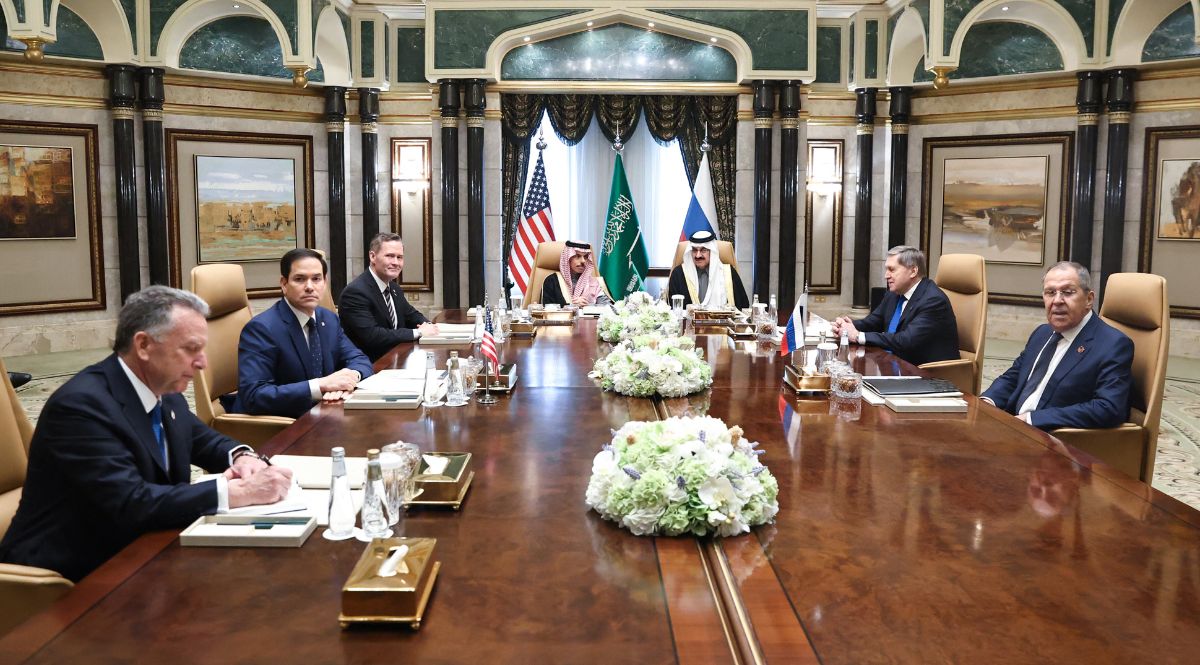U.S. and Russia Start Negotiations on Ending the War in Ukraine
The Trump administration’s priority is to end the conflict in Ukraine as soon as possible and transfer the responsibility for so-called security guarantees to European countries. Since such guarantees would be ineffective without coordinated action by the U.S. and Europe, the Trump administration’s decisions may make it easier for Russia to achieve its main goals regarding Ukraine and European security.
 AA/ABACA / Abaca Press / Forum
AA/ABACA / Abaca Press / Forum
The official introduction to the negotiations was a telephone conversation between U.S. President Donald Trump and Russian leader Vladimir Putin on 12 February, followed by a conversation between Secretary of State Marco Rubio and Russian Foreign Minister Sergey Lavrov (15 February). On 18 February, delegations from both countries met in Saudi Arabia, where they agreed on technical issues related to the conduct of the talks, including the establishment of special teams.
The U.S. Approach to the Negotiations
Even before the negotiations began, the U.S. set the framework for a possible compromise with Russia. Trump and his representatives stated that it is unrealistic for the negotiations to result in Ukraine gaining NATO membership, that the U.S. does not plan to send troops to Ukraine, and that regaining the territories controlled by Russia is impossible. They also signalled that if the negotiations bring positive results, new forms of cooperation with Russia and the lifting of sanctions imposed on it will be possible. Although the U.S. initially ruled out Europe’s participation in the talks, it admitted that it may be necessary as the EU also imposed sanctions against Russia. The U.S. announced that it would include Ukraine in the talks, while simultaneously conducting negotiations with it on access to rare earths and other natural resources. According to Trump, they are to be compensation for the assistance provided to Ukraine, but the proposals the U.S. presented (to outright own or receive revenue from 50% of Ukrainian resources) indicate rather an attempt to exploit a country defending itself against aggression.
The Trump administration’s actions have weakened the expected initial negotiating position of the U.S. and indicate that its goal is to reach an agreement as soon as possible. Earlier decisions by the Joe Biden administration, supported by a coalition of around 50 countries, created an appropriate basis for defending Ukrainian interests during the negotiations. It was possible to start the talks from a position of strength by threatening Russia with additional sanctions. Although there was no consensus in NATO on inviting Ukraine to the Alliance (the U.S. was against it, as was Germany), it was possible to provide it with other security guarantees. All NATO countries, as well as some Alliance partners, have signed bilateral security agreements with Ukraine, which were to facilitate maintaining support over the next 10 years. NATO has announced that it will transfer equipment and weapons worth around €40 billion to Ukraine in 2025 and has taken over responsibility for coordinating aid from the United States. The Biden administration also announced the deployment of long-range missile systems in Germany in 2026, which would strengthen the credibility of deterrence and American guarantees within NATO.
The new administration in turn stated that guarantees for Ukraine should be supported by the military presence of European and non-European countries, without the participation of U.S. forces. It stipulates that these forces will not be covered by the security guarantees of Article 5. Although some countries would be ready for this, the ability to create such a mission will depend on U.S. policy towards NATO. The U.S. has assured that it does not plan to withdraw troops from Europe, but is conducting a review of its global engagement. Some NATO countries fear that after negotiating a ceasefire in Ukraine, the U.S. will reduce its presence in Europe, which will lead to a weakening of American security guarantees. In that situation, Russia could treat the presence of European troops in Ukraine as a pretext for an attack on Alliance territory. The U.S. may in that case decide that such an attack is not a justification for invoking Article 5, which would drastically undermine the credibility of the Alliance.
The Possibility of Russia Achieving Its Goals
With the start of negotiations, Russia’s chances of attaining its main goals for Ukraine in the medium term have increased. The strategic goal remains to permanently block Ukraine’s path to NATO (neutralisation). It seems that the U.S. generally considers Ukraine’s membership in the Alliance in the short term to be unrealistic for many reasons, including the lack of European unity in this matter and the military weakness of European allies. Therefore, the U.S. is ready for some form of declaration on this subject, but the nature of such an agreement will be important. Russia will strive to ensure that Ukraine’s neutralisation is permanent. It demands that NATO withdraw from the 2008 declaration according to which Ukraine and Georgia are to be members of the Alliance in the future. Since fulfilling these demands would mean de facto recognition of a Russian sphere of influence, it is doubtful that the U.S. allies will agree to this. However, the Russian authorities may convince the U.S. to pressure Ukraine to include provisions on neutrality in its constitution (such a provision existed since 2010, but was removed after the annexation of Crimea) and in a bilateral ceasefire agreement or a treaty. Russia also has a chance to achieve its goal of changing the government in Ukraine (which Russian propaganda calls “de-nazification”). Putin is undermining the democratic legitimacy of President Volodymyr Zelensky and is trying to force new elections and a lack of a sense of security in society and the possibility of interfering in its electoral process to elect new authorities who may be ready to accept unfavourable ceasefire conditions. Putin’s position on this matter was supported by Trump, who referred to Zelensky as a “dictator”.
All this would increase the chances of Russia achieving its long-term goals of the demilitarisation of Ukraine, recognition of the annexation of Crimea and four other regions (which Russian troops do not fully control), and political subordination of Ukraine. Even if the U.S. does not agree to Ukraine’s demilitarisation during the negotiations, it may withdraw from providing it with further military support. Ukrainians’ morale and the country’s ability to defend itself would then be seriously weakened. Although with increased support from European countries taking control of the annexed regions would entail huge costs for Russia, after a ceasefire and time rebuilding its military, Russia could resume the war of attrition. Russia will also use the negotiations with the U.S. to move closer to its strategic goals presented in the ultimatum to the U.S. and NATO in December 2021. At that time, the Russian authorities demanded, among other things, the withdrawal of foreign troops from countries admitted to the Alliance after 1997, which would weaken the Alliance’s ability to deter and defend its borders and members. The Trump administration could choose to meet the Russian demands after a ceasefire by, for example, reducing the U.S. military presence in the Western Balkans, which would increase Russia’s ability to exert influence in that region. Any reduction in U.S. military presence in Europe and a halt to Biden’s decision to deploy long-range systems in Germany would lead to a weakening of the credibility of the U.S. security guarantee. As a result, it would be easier for Russia to threaten escalation against NATO in order to cause divisions in the Alliance.
Conclusions and Perspectives
The way the U.S. is conducting the negotiations creates a risk that it will be difficult for Ukraine and its European partners to accept whatever agreement is negotiated. Rejecting such an agreement could bolster Trump’s argument that supporting Ukraine and Europe is not in the American interest. This would create a strategic threat to Europe, as European countries would have limited possibilities to provide guarantees to Ukraine without increasing the risk of direct confrontation with Russia.
Although initially some European countries signalled their readiness to send troops to Ukraine, this was probably an attempt to pressure the Trump administration to include Europe in the negotiations and take into account its security interests. The establishment of such a mission would require coordinated actions by European countries and the U.S. It is also not very likely that an agreement between Ukraine and the U.S. on access to raw materials would change Trump’s attitude towards Ukraine or approach to negotiations with Russia. That is why it is important that Ukraine receive U.S. security guarantees in exchange. Despite the declaration that the U.S. will not send troops to Ukraine, it could support the military presence of other countries in various ways (e.g., reconnaissance and logistics). In order to increase Europe’s influence on Trump, a group of the continent’s strongest countries could present him with a broader offer, for example, proposing purchases of equipment and weapons from the U.S. of significant value. EU countries could also emphasise the growing importance of imports of American LNG or nuclear technologies. At the same time, it will be necessary to present a plan for the rapid strengthening of NATO’s European pillar. To this end, it will be necessary to convince EU countries to, among other things, use joint financing for defence investments. As part of the development of NATO’s European pillar, it will also be crucial to develop European defence capabilities that strengthen conventional deterrence independent of the U.S. This applies especially to long-range strike systems as part of the project announced in July 2024 (European Long Range Strike Approach, ELSA), which included France, Germany, Poland, and Italy, and was later joined by the United Kingdom, Sweden, and the Netherlands.



.png)
.png)
.jpg)